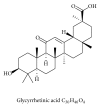Glycyrrhizic acid in the treatment of liver diseases: literature review
- PMID: 24963489
- PMCID: PMC4052927
- DOI: 10.1155/2014/872139
Glycyrrhizic acid in the treatment of liver diseases: literature review
Abstract
Glycyrrhizic acid (GA) is a triterpene glycoside found in the roots of licorice plants (Glycyrrhiza glabra). GA is the most important active ingredient in the licorice root, and possesses a wide range of pharmacological and biological activities. GA coupled with glycyrrhetinic acid and 18-beta-glycyrrhetic acid was developed in China or Japan as an anti-inflammatory, antiviral, and antiallergic drug for liver disease. This review summarizes the current biological activities of GA and its medical applications in liver diseases. The pharmacological actions of GA include inhibition of hepatic apoptosis and necrosis; anti-inflammatory and immune regulatory actions; antiviral effects; and antitumor effects. This paper will be a useful reference for physicians and biologists researching GA and will open the door to novel agents in drug discovery and development from Chinese herbs. With additional research, GA may be more widely used in the treatment of liver diseases or other conditions.
Figures
Similar articles
-
Glycyrrhetinic acid alleviates hepatic inflammation injury in viral hepatitis disease via a HMGB1-TLR4 signaling pathway.Int Immunopharmacol. 2020 Jul;84:106578. doi: 10.1016/j.intimp.2020.106578. Epub 2020 May 8. Int Immunopharmacol. 2020. PMID: 32416454 Free PMC article.
-
A drug over the millennia: pharmacognosy, chemistry, and pharmacology of licorice.Yakugaku Zasshi. 2000 Oct;120(10):849-62. doi: 10.1248/yakushi1947.120.10_849. Yakugaku Zasshi. 2000. PMID: 11082698 Review.
-
Water extract of licorice had anti-viral activity against human respiratory syncytial virus in human respiratory tract cell lines.J Ethnopharmacol. 2013 Jul 9;148(2):466-73. doi: 10.1016/j.jep.2013.04.040. Epub 2013 Apr 30. J Ethnopharmacol. 2013. PMID: 23643542 Free PMC article.
-
Research progress on the protective effects of licorice-derived 18β-glycyrrhetinic acid against liver injury.Acta Pharmacol Sin. 2021 Jan;42(1):18-26. doi: 10.1038/s41401-020-0383-9. Epub 2020 Mar 6. Acta Pharmacol Sin. 2021. PMID: 32144337 Free PMC article. Review.
-
18Beta-glycyrrhetinic acid ameliorates acute Propionibacterium acnes-induced liver injury through inhibition of macrophage inflammatory protein-1alpha.J Biol Chem. 2010 Jan 8;285(2):1128-37. doi: 10.1074/jbc.M109.037705. Epub 2009 Nov 6. J Biol Chem. 2010. PMID: 19897483 Free PMC article.
Cited by
-
Solubility, Permeability, Anti-Inflammatory Action and In Vivo Pharmacokinetic Properties of Several Mechanochemically Obtained Pharmaceutical Solid Dispersions of Nimesulide.Molecules. 2021 Mar 10;26(6):1513. doi: 10.3390/molecules26061513. Molecules. 2021. PMID: 33802031 Free PMC article.
-
Evaluation of Glycyrrhizic Acid Therapeutic Effect and Safety in Mycoplasma gallisepticum (HS Strain)-Infected Arbor Acres Broilers.Animals (Basel). 2022 May 17;12(10):1285. doi: 10.3390/ani12101285. Animals (Basel). 2022. PMID: 35625131 Free PMC article.
-
Liver Injury Associated with COVID-19 Infection: Pathogenesis, Histopathology, Prognosis, and Treatment.J Clin Med. 2023 Mar 6;12(5):2067. doi: 10.3390/jcm12052067. J Clin Med. 2023. PMID: 36902854 Free PMC article. Review.
-
Glycyrrhizic Acid Inhibits Proliferation of Gastric Cancer Cells by Inducing Cell Cycle Arrest and Apoptosis.Cancer Manag Res. 2020 Apr 24;12:2853-2861. doi: 10.2147/CMAR.S244481. eCollection 2020. Cancer Manag Res. 2020. PMID: 32425599 Free PMC article.
-
COVID-19 and Liver Dysfunction: Current Insights and Emergent Therapeutic Strategies.J Clin Transl Hepatol. 2020 Mar 28;8(1):18-24. doi: 10.14218/JCTH.2020.00018. Epub 2020 Mar 30. J Clin Transl Hepatol. 2020. PMID: 32274342 Free PMC article. Review.
References
-
- Gujral ML, Sareen K, Phukan DP, Amma MK. Anti-arthritic activity of glycyrrhizin in adrenalectomised rats. Indian Journal of Medical Sciences. 1961;15:625–629. - PubMed
-
- Kumagai A, Nanaboshi M, Asanuma Y, Yagura T, Nishino K. Effects of glycyrrhizin on thymolytic and immunosuppressive action of cortisone. Endocrinologia Japonica. 1967;14(1):39–42. - PubMed
-
- Pompei R, Flore O, Marccialis MA, Pani A, Loddo B. Glycyrrhizic acid inhibits virus growth and inactivates virus particles. Nature. 1979;281(5733):689–690. - PubMed
-
- Kiso Y, Tohkin M, Hikino H, Sakamoto T, Namba T. Mechanism of antihepatotoxic activity of glycyrrhizin. I: effect on free radical generation and lipid peroxidation. Planta Medica. 1984;50(4):298–302. - PubMed
-
- Leroy AL. Contribution a' l'étude des propriétés pharmacodynamiques dex extraits de reglisse (Glycyrrhiza glabra kgumineuse) [Thesis] University of Paris, Faculty of Medicine; vol. 592, pp. 1–49, 1959.
Publication types
MeSH terms
Substances
LinkOut - more resources
Full Text Sources
Other Literature Sources
Medical




